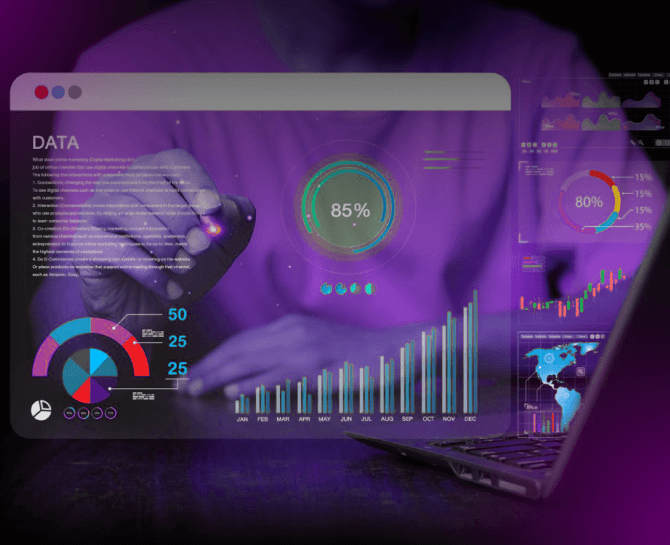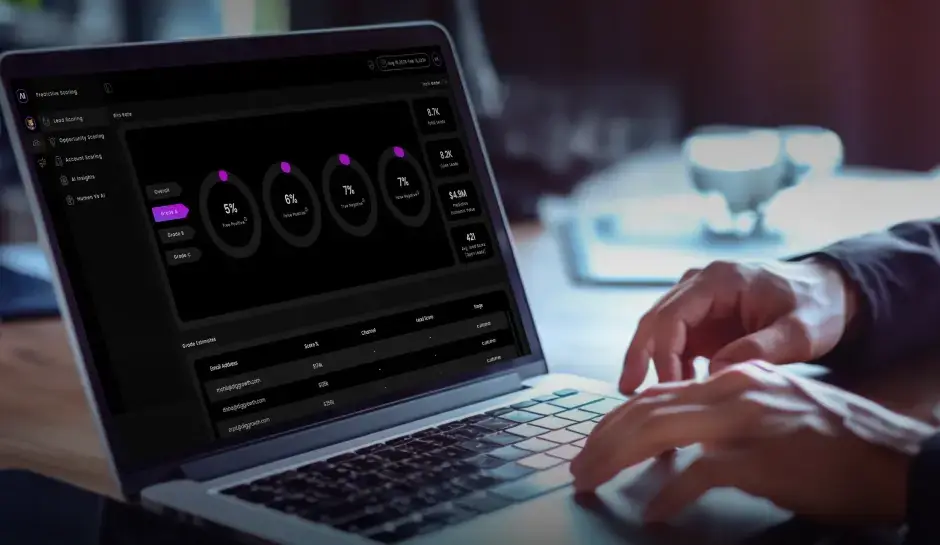
Advertising Dashboard: Monitoring and Enhancing Campaign Performance
An advertising dashboard serves as a tool in marketing. It enables the monitoring, tracking, and analysis of advertising campaigns and offers an overview of metrics associated with advertisements, such as impressions, clicks, conversions, and return on investment (ROI). An advertising dashboard is significant for businesses and marketers as it provides insights into campaign performance. By visualizing real-time data through this tool, marketers can quickly identify trends, patterns, and areas that require improvement.
Advertising dashboards offer the flexibility to customize and filter data according to requirements. This enables marketers to view campaign performance across channels like social media platforms, search engines, and display networks.
As a result, they can determine which channels are most effective and allocate budgets accordingly. This strategic approach leads to increased customer engagement and enhanced brand awareness. Ultimately, it drives revenue growth.
By leveraging this tool marketers can efficiently monitor, measure, and optimize their advertising campaigns while achieving greater effectiveness, improved targeting, and overall success.
Overview of Marketing Dashboards
Marketing dashboards offer a view of an advertising campaign’s performance and critical metrics presented in an appealing way. They serve as a hub for marketers to monitor, analyze, and optimize their advertising efforts.
These dashboards consist of components and features that enable users to track various aspects of their campaigns.
These include:
- Real-time data
- Data visualization
- Performance Indicators
They provide real-time data on metrics like impressions, clicks, conversions, and revenue. This up-to-date information empowers marketers to make decisions and optimize their campaigns accordingly.
To enhance understandability, marketing dashboards utilize charts, graphs, and other visual elements to present data in a format. This visual representation enables marketers to identify trends, patterns, and anomalies in their campaign performance.
Marketing dashboards allow users to define and monitor performance indicators (KPIs) aligned with their campaign goals. These KPIs may include click-through rate (CTR), return on ad spend (ROAS), or cost per acquisition (CPA).
Overall, marketing dashboards provide marketers with insights into the effectiveness of their advertising campaigns while facilitating data-driven decision-making for improved ROI.
Using a marketing dashboard offers advantages for advertisers, including:
- Making decisions based on data
- Boosting efficiency and productivity
- Continuous performance monitoring
Dashboards provide marketers with insights from real-time data, empowering them to make well-informed choices and fine-tune their advertising strategies.
Marketing dashboards streamline the process of gathering and analyzing data by consolidating information from sources into a platform. This saves advertisers time and effort, enabling them to focus on tasks that drive results.
Dashboards enable marketers to track the performance of their campaigns consistently and measure progress towards their objectives. This facilitates the identification of areas that need improvement, allowing for adjustments and maximizing campaign effectiveness.
Key Metrics and Performance Indicators
The success of any advertising campaign relies heavily on tracking and analyzing performance indicators (KPIs). By comprehending these metrics and closely monitoring performance indicators, marketers can make grounded decisions based on data insights while optimizing campaigns for outcomes.
When it comes to advertising dashboards, there are metrics and performance indicators that you should keep an eye on and analyze;
- Ad impressions:
- Click-through rates (CTR)
- Conversion rates
- Ad spending
- Ad targeting
This metric tells you how many times your ad has been shown to users. It helps you understand the reach and visibility of your campaign.
CTR measures the percentage of users who click on your ad after seeing it. It shows how effective your ads’ message and design are.
Conversion rates track the percentage of users who completed a desired action, like purchasing or filling out a form. It indicates how well your ad is turning viewers into customers.
It refers to the money invested in your advertising campaign. Keeping an eye on this metric helps you understand if your ads are cost-effective and lets you optimize your budget allocation.
Ad targeting metrics provide insights into which audience segments are engaging with your ads. By analyzing these metrics, you can refine your targeting strategy. Reach the audience.
These metrics and performance indicators offer insights into the effectiveness and efficiency of your advertising campaigns.
By monitoring and analyzing the data in your advertising dashboard, you can discover patterns and spot areas for improvement. Make informed decisions to optimize your campaigns.
Choosing the Right Analytics Tool for Your Advertising Dashboard
When creating an advertising dashboard, selecting the perfect analytics tool is essential. The analytics tool you opt for will determine how accurate and user-friendly the data displayed on your dashboard will be.
Here are some key factors to consider when choosing the analytics tool for your advertising dashboard:
- User-Friendly Interface
- Integration Capabilities
- Customization Options
- Reporting Functionalities
Make sure the analytics tool is intuitive and easy to navigate so you can effortlessly comprehend and analyze the provided data.
Look for an analytics tool that seamlessly integrates with your existing advertising platforms like Google Ads or Facebook Ads. This way, you can consolidate all your advertising data in one place for analysis.
Every business has reporting requirements. Ensure the chosen analytics tool offers customization options, enabling you to tailor the dashboard to metrics and key performance indicators (KPIs) for your advertising campaigns.
A robust analytics tool should offer various reporting functionalities, such as real-time data updates, automated reports, and appealing visualizations. This will allow you to share insights with your team and stakeholders easily.
While there are analytics tools on the market, selecting one that aligns with your specific needs and preferences is crucial. Here are a few popular choices to consider:
- Google Analytics
- Adobe Analytics
- HubSpot
Renowned for its tracking capabilities, Google Analytics offers a range of features for monitoring advertising performance. It provides information about website traffic, conversion rates, and audience demographics.
Adobe Analytics is a tool that provides advanced segmentation funnel analysis and attribution modeling. It enables you to measure the impact of your advertising campaigns across channels and touchpoints.
HubSpot offers an all-in-one marketing software that includes analytics capabilities. It has a user interface, real-time reporting, and seamless integration with HubSpot tools.
Ultimately, selecting the analytics tool for your advertising dashboard depends on your business objectives, budget considerations, and specific requirements. Take the time to evaluate options and choose the tool that best suits your needs. By implementing an analytics tool like this, you can monitor and optimize your advertising campaigns for impact.
Creating an Effective Advertising Dashboard
Tips for designing an advertising dashboard that looks appealing and is easy to comprehend. To ensure the communication of insights to users, it’s essential that an advertising dashboard appears visually pleasing and is easily understandable.
Here are some practical suggestions for designing such a dashboard;
- Keep it simple
- Utilize visual elements
- Choose colors thoughtfully
- Ensure readability
- Consistent branding
Adopt a minimalist design approach to simultaneously prevent users with excessive information.
charts, graphs, and other visual aids to data in a more digestible and engaging manner.
Use colors strategically to emphasize metrics and establish a visual hierarchy.
Employ fonts and appropriate font sizes so users can effortlessly read and comprehend the information presented.
Maintain uniform elements, including logos and color schemes, to reinforce brand recognition.
User Experience And Accessibility
When creating an advertising dashboard, prioritizing user experience (UX) and accessibility is crucial. Here are a few factors worth considering;
- Responsive Design
- Accessible Design
- User-Friendly Navigation
- Fast Loading Speed
Ensures compatibility with devices and screen sizes to provide users with a seamless experience across platforms.
Adhere to accessibility guidelines by incorporating features like text for images so that individuals with disabilities can use the dashboard effectively.
Creating user navigation is essential to help users quickly navigate through the dashboard. This can be achieved by implementing navigation elements, like menus and filters.
Additionally, optimizing the dashboard’s performance is crucial to ensure loading speeds, providing users with an experience.
Tips for organizing and presenting data effectively for quick insights and decision-making
When it comes to organizing and presenting data effectively, here are some tips can help users gain insights and make informed decisions:
- Grouping data
- Highlighting metrics
- Providing views
- Incorporating elements
- Regularly updating data
Organizing data into groups or categories is beneficial. This enables users to find and compare information efficiently.
Emphasizing metrics by using bold or color can draw attention and allow users to identify critical insights quickly.
Allowing users to personalize the dashboard by selecting metrics or segments they are interested in can enhance their decision-making process.
Interactive elements such as charts or drill-down functionality enables users to explore data further, making it easier to analyze and understand the information presented.
It’s essential to ensure that the displayed data is up to date and refreshed either in time or at intervals. This helps maintain relevance and accuracy for decision-making.
Implementing these tips will create an organized, visually appealing, user-friendly dashboard that facilitates insights and effective decision-making.
Generating Comprehensive Reports from Your Advertising Dashboard
Once you’ve successfully set up your advertising dashboard and are actively monitoring metrics and performance indicators, there may come a time when you need to create reports to share with clients or stakeholders.
These reports serve as an overview of your advertising campaigns, showcasing discoveries, valuable insights, and recommendations for future optimization.
How to Generate In-Depth Reports from the Advertising Dashboard
To generate reports from your advertising dashboard, you can follow these steps:
- Choose the period for your report, whether weekly, monthly, or quarterly.
- Analyze campaign performance by assessing metrics like conversion rate, click-through rate (CTR), return on ad spend (ROAS), and cost per acquisition (CPA).
- Utilize visual aids such as graphs and charts to data in an easily digestible format.
- Include a summary highlighting the performance of your advertising campaigns within the chosen timeframe.
- Offer findings and insights that will aid stakeholders in comprehending both triumphs and obstacles faced during the campaigns.
- Suggest improving future campaigns based on the information and insights gathered from the advertising dashboard.
Key Components in an In-depth Advertising Campaign Report
An in-depth advertising campaign report should cover the following components;
- An overview of how the advertising campaigns performed, including essential metrics and notable highlights.
- Valuable observations and insights will be gained from analyzing the campaign data, such as emerging trends, patterns, and areas that can be enhanced.
- Recommendations for Optimization and Future Campaigns are recommendations to enhance campaign performance and achieve results in future campaigns.
By incorporating these elements into your advertising campaign report, you will provide an assessment of the campaign performance along with insights for further improvement.
Collaboration and Communication with Clients
As a marketing professional, it is crucial to involve your clients in monitoring and analyzing the performance of their advertising campaigns. By engaging clients in this process, you do not establish trust.
Also, ensure they have a clear understanding of their campaign progress. This collaborative approach enables decision-making. Allows for timely adjustments when needed.
When effectively communicating data and insights to clients using the advertising dashboard, it is essential to prioritize clarity above all else. To effectively convey information to clients, it’s necessary to present it in an easy-to-understand way. This helps them grasp the metrics and comprehend the impact of their campaign performance. Including aids, like charts and graphs, can also make the data more digestible and enhance comprehension.
Another effective strategy to boost client collaboration and engagement is to provide shared access to an advertising dashboard with features. By granting clients access to this dashboard, they can actively participate in the analysis process and feel more involved in decision-making. This fosters a sense of ownership and empowerment, leading to engagement and satisfaction with the campaign’s results.
Moreover, incorporating elements such as commenting and messaging functions within the dashboard facilitates communication between you and your clients. It enables feedback exchange, ensuring everyone is on the page promptly and addressing any questions or concerns that may arise.
Ensuring the Accuracy and Security of Data
When it comes to an advertising dashboard, one of the aspects is ensuring that the data it provides is accurate and reliable. With data, the entire effectiveness of the dashboard is maintained.
This discussion will delve into why data accuracy and security are so important in an advertising dashboard. We will also explore strategies for verifying and validating data sources within the dashboard while highlighting measures for safeguarding client and campaign information.
The Significance of Data Integrity and Accuracy in an Advertising Dashboard
Having data is critical for making informed decisions and optimizing advertising campaigns. Marketers who need more information may base their strategies on assumptions, resulting in ineffective targeting and wasted resources.
Data integrity guarantees that the information presented in the dashboard is dependable, consistent, and free from errors or discrepancies. By ensuring data accuracy, marketers can confidently rely on insights and metrics provided by the dashboard as a reflection of the actual performance of their advertising efforts.
Approaches to Verify and Validate Data Sources within the Dashboard
Verifying and validating all data sources within the advertising dashboard is vital to upholding data accuracy. This involves conducting audits and cross-referencing platform information to ensure consistency and reliability.
Implementing processes for data validation, such as automated checks and manual reviews, can be beneficial in identifying any discrepancies or anomalies in the collected data. It is also essential to monitor and update the data sources to ensure the information on the dashboard is up-to-date.
Data Security Measures and Best Practices to Protect Client and Campaign Data
Data security is crucial when it comes to client and campaign information. To protect this data from access, breaches, or leaks, it is essential to implement security measures and follow best practices. This may involve using transfer protocols, encryption techniques, access controls, and backing up the data.
In addition to these measures, creating a culture of privacy around data and providing training on security best practices for employees can help mitigate potential threats and maintain the safety of client and campaign information.
The Future of Advertising Dashboards
Looking ahead into the future of advertising dashboards brings possibilities as technology advances. Marketers can anticipate enhancements in data visualization, automation, and predictive analytics due to emerging trends and advancements in advertising dashboard technologies.
One notable trend in advertising dashboards is the integration of intelligence (AI) and machine learning (ML) capabilities. This integration allows for analysis and decision-making within the dashboard system.
AI algorithms powered by machine learning can analyze amounts of data and provide real-time insights, empowering marketers to make efficient data-driven decisions. These algorithms can also optimize advertising campaigns by learning from user behavior patterns and adjusting targeting and ad placements.
Another exciting development is integrating augmented reality (AR) and virtual reality (VR) technologies in advertising. This opens up possibilities for creating interactive advertising experiences. Just imagine showcasing products or services through VR simulations, allowing customers to explore and interact with them virtually before making a purchase decision.
As the advertising landscape becomes more complex, it is expected that advertising dashboards will need to adapt to meet the changing industry demands. One prediction is that these dashboards will become highly customizable, allowing marketers to create tailored views based on their needs and preferences. This level of customization will enable marketers to focus on the metrics and performance indicators for their campaigns.
Furthermore, as multi-channel marketing strategies continue to gain momentum, it will be crucial
for advertising dashboards to integrate data from channels and platforms seamlessly. This integrated approach will give marketers a view of their advertising efforts, enabling them to make informed decisions based on comprehensive data analysis.
When choosing an advertising dashboard tool, thinking about future-proofing strategies is crucial. Technology advances rapidly. What’s cutting edge today could quickly become outdated. Therefore, marketers should opt for an adaptable dashboard tool to keep up with advancements.
Moreover, considering the flexibility and compatibility of the tool with emerging technologies like AI and VR is vital to ensure that the dashboard can leverage these innovations as they become more mainstream.
Final Thoughts
All in all, leveraging an advertising dashboard offers many benefits. It adds value to optimizing advertising campaigns, enables data analysis, real-time monitoring, and efficient decision-making by centralizing all information. This consolidation saves marketers time and effort, allowing them to focus on planning to achieve their campaign objectives.
Through the utilization of an advertising dashboard, marketers can effortlessly identify trends and pinpoint areas for improvement. Make informed decisions based on data insights to maximize their return on investment (ROI). It empowers them to maintain an edge by adapting their strategies using up-to-date information.
Are you a modern marketer who would like to master advertising dashboards? Then let’s get connected! DiGGrowth enables you to access these dashboards and streamline campaign management processes while providing insights that assist your business in accomplishing your advertising goals. Contact us at info@diggrowth.com for more details on how our experts can help in optimzing your marketing strategies.
Ready to get started?
Increase your marketing ROI by 30% with custom dashboards & reports that present a clear picture of marketing effectiveness
Start Free Trial
Experience Premium Marketing Analytics At Budget-Friendly Pricing.

Learn how you can accurately measure return on marketing investment.
Additional Resources
The Future of Marketing: How Predictive Lead and Account Scoring is Changing the Game
Can we, in this incredible marketing landscape driven...
Read full post postCloud Wars: A Comparative Analysis of Leading Cloud Vendors
How many companies are using cloud computing? Around...
Read full post postContent Marketing Attribution: Tracking Content Impact Across the Customer Journey
So, you've poured your heart into crafting the...
Read full post postFAQ's
A dashboard in advertising refers to a visual representation of key performance indicators (KPIs) and metrics related to advertising campaigns. It provides a comprehensive overview of the performance of various advertising activities, such as clicks, impressions, conversions, and other relevant data, allowing advertisers to monitor and analyze the effectiveness of their campaigns.
A marketing dashboard should typically include essential metrics and KPIs such as website traffic, conversion rates, customer acquisition cost, return on investment (ROI), customer lifetime value, and other relevant data points. Additionally, it may incorporate data visualization elements, such as graphs, charts, and tables, to facilitate quick and comprehensive data analysis.
To create a marketing dashboard, you should first identify the key performance metrics that align with your marketing goals. Then, select a suitable dashboard creation tool or software, such as Google Data Studio, Tableau, or Microsoft Power BI. Import and integrate your data sources, design the layout, and incorporate visual elements for data representation. Ensure that the dashboard is user-friendly and provides actionable insights for informed decision-making.
To put together a dashboard for ad campaign performance, begin by selecting the relevant metrics, including impressions, clicks, click-through rates, conversion rates, cost per acquisition, and return on ad spend. Utilize a dashboard creation tool to integrate data from advertising platforms like Google Ads, Facebook Ads, or other relevant sources. Design the dashboard layout, incorporate visualizations such as line graphs, bar charts, and tables, and ensure the dashboard provides a comprehensive overview of the campaign's performance, allowing for easy monitoring and analysis.
 Rahul Saini
Rahul Saini  Sameer Pawar
Sameer Pawar 

